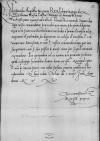Letter #3105
Sigismund II Augustus Jagiellon to Ioannes DANTISCUSVilnius, 1547-06-05
| received Heilsberg (Lidzbark Warmiński), 1547-08-21 Manuscript sources:
| ||||
Text & apparatus & commentaryPlain textText & commentaryText & apparatus
Reverendissimo in Christo Patri, domino
Reverendissime in Christo Pater sincere nobis dilecte
Plemieczki a nonnullis senatoribus regni nostri commendatus servit nobis non minore fide quam diligentia. Quia vero frater eius Bartholomeus ius habet a summo pontifice ad canonicatum et praebendam seu dignitatem in ecclesia et mensibus Paternitatis Vestrae vacaturam, petiti sumus, ut eum Paternitati Vestrae commendaremus, quo iure suo potiatur aut, si fieri posset, in mense etiam suo, si quid vacaverit, ei provideret. Pro quo quidem vel eo nomine non gravatim scribimus, quod a plerisque hominibus dicatur bonus vir esse. Quicquid igitur Paternitas Vestra in rem eius fecerit, rem nobis factura gratam gratia nostra referendam.
Et be written over o⌈oee written over o⌉ne valeat.
Ex commissione sacrae


 BNW, BOZ 954, f. 18v
BNW, BOZ 954, f. 18v